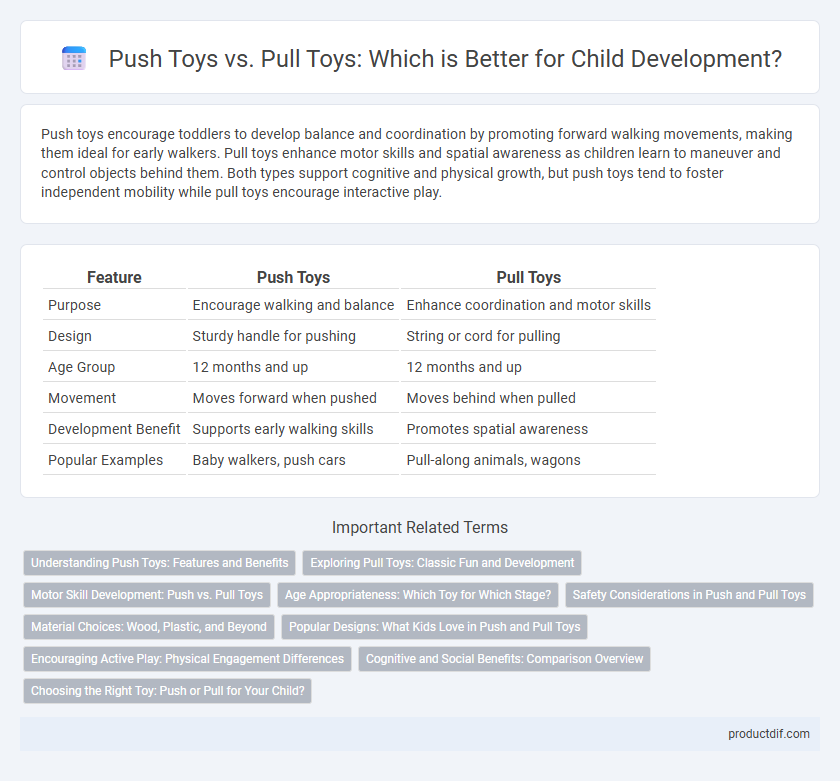Push toys encourage toddlers to develop balance and coordination by promoting forward walking movements, making them ideal for early walkers. Pull toys enhance motor skills and spatial awareness as children learn to maneuver and control objects behind them. Both types support cognitive and physical growth, but push toys tend to foster independent mobility while pull toys encourage interactive play.
Table of Comparison
| Feature | Push Toys | Pull Toys |
|---|---|---|
| Purpose | Encourage walking and balance | Enhance coordination and motor skills |
| Design | Sturdy handle for pushing | String or cord for pulling |
| Age Group | 12 months and up | 12 months and up |
| Movement | Moves forward when pushed | Moves behind when pulled |
| Development Benefit | Supports early walking skills | Promotes spatial awareness |
| Popular Examples | Baby walkers, push cars | Pull-along animals, wagons |
Understanding Push Toys: Features and Benefits
Push toys encourage toddlers to develop gross motor skills, balance, and coordination through forward movement. These toys often feature sturdy handles, wide bases, and wheels designed to provide stability and ease of use for early walkers. Popular push toy examples include baby walkers, doll strollers, and toy lawn mowers, all promoting active play and physical development.
Exploring Pull Toys: Classic Fun and Development
Pull toys foster motor skills and hand-eye coordination by encouraging toddlers to walk and maneuver objects using a string or handle. Classic designs like wooden animals or cars with wheels promote balance and spatial awareness while engaging a child's imagination. These toys support early physical development and inspire active, exploratory play, making them timeless favorites for young learners.
Motor Skill Development: Push vs. Pull Toys
Push toys encourage children to develop balance, coordination, and gross motor skills by promoting forward movement and weight shifting. Pull toys enhance fine motor skills and hand-eye coordination as children learn to grasp and control the toy's movement. Both types of toys support spatial awareness and muscle strengthening, essential for early childhood motor development.
Age Appropriateness: Which Toy for Which Stage?
Push toys are ideal for toddlers aged 12 to 24 months who are beginning to develop walking skills, offering support and encouraging balance. Pull toys suit slightly older children aged 18 to 36 months, enhancing coordination and motor planning as they walk independently. Selecting age-appropriate push or pull toys promotes developmental milestones in gross motor skills effectively.
Safety Considerations in Push and Pull Toys
Push toys often provide greater stability and reduce the risk of tipping, making them safer for toddlers developing balance and coordination. Pull toys should feature sturdy strings with a breakaway mechanism to prevent choking hazards and avoid entanglement. Both toy types benefit from non-toxic materials, smooth edges, and compliance with ASTM F963 safety standards to minimize injury risks.
Material Choices: Wood, Plastic, and Beyond
Push toys and pull toys vary significantly in material choices, with wood and plastic being the most common options. Wood offers durability, a natural aesthetic, and eco-friendliness, while plastic provides lightweight designs and vibrant colors appealing to children. Emerging materials such as silicone and recycled composites further enhance safety and sustainability in toy manufacturing.
Popular Designs: What Kids Love in Push and Pull Toys
Popular push toys often feature vibrant colors and easy-to-grip handles, encouraging toddlers to develop balance and coordination while walking. Pull toys commonly include animals or vehicles with wheels and a sturdy cord, motivating children to engage in active play and improve motor skills. Both designs integrate interactive elements like sounds or moving parts to captivate young minds and support sensory development.
Encouraging Active Play: Physical Engagement Differences
Push toys promote active play by encouraging toddlers to walk and build balance, enhancing gross motor skills through forward movement and weight shifting. Pull toys engage children by stimulating coordination and spatial awareness as they follow and control the toy's movement, often involving backward or lateral steps. Both types of toys are essential for developing physical engagement but target different muscle groups and movement patterns.
Cognitive and Social Benefits: Comparison Overview
Push toys encourage toddlers to develop motor skills and balance by promoting forward movement and spatial awareness, enhancing their cognitive understanding of cause and effect. Pull toys foster social interaction and imaginative play, as children often engage in role-playing scenarios while following or leading others, boosting communication skills. Both push and pull toys contribute uniquely to early childhood development by stimulating problem-solving abilities and collaborative behavior.
Choosing the Right Toy: Push or Pull for Your Child?
Push toys promote motor skill development and balance as children learn to walk and gain confidence through forward movement. Pull toys encourage coordination and spatial awareness by motivating toddlers to follow and manipulate objects behind them. Selecting the right toy depends on your child's current developmental stage and preferences for interactive play activities.
Push toys vs pull toys Infographic

 productdif.com
productdif.com